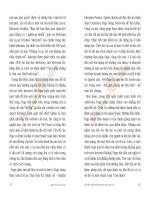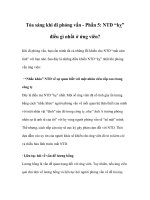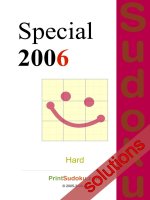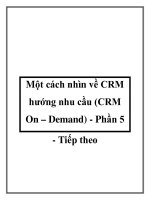Home Made Money PHẦN 5 ppt
Bạn đang xem bản rút gọn của tài liệu. Xem và tải ngay bản đầy đủ của tài liệu tại đây (74.09 KB, 12 trang )
AARP HOME MADE MONEY | 37
Careful Spending
Be wary of anyone who wants to sell you something, and suggests a reverse
mortgage as a way to pay for it. Be especially wary if
• you do not fully understand what they are selling; or
• you are not certain that you need what they are selling.
Remember that the total cost to you equals the cost of what they are selling
plus the cost of the reverse mortgage. If you conclude that you do need what
they are selling, be sure to shop around before making a decision. You are
under no obligation to buy goods or services from the party that suggested
you borrow against your home to pay for them.
For example, if an insurance agent tries to sell you an annuity by way of
reverse mortgage financing, be sure to check out all the information about
these types of arrangements at www.aarp.org/revmort. Click on “Key
Decisions” under “Reverse Mortgages” on the left, and then on “Spending
Your Equity.”
Refinancing
After you get a reverse mortage, sometime in the future you may be able to
increase the loan funds available to you by refinancing the loan. Large
increases in your home’s value, increases in HUD’s 203-b limits, or lower
interest rates could make this possible.
When you refinance a HECM, lenders are required to show you the total
cost of refinancing, and compare it to the increase in available loan funds
that a refinance would provide.
This comparison makes it easy for you to see the total costs that would be
added to the amount you owe versus the additional loan funds that would
become available to you. If you need help understanding the comparison,
HECM counselors can explain it to you.
38 | AARP HOME MADE MONEY
Glossary
203-b limit
in the federally insured HECM program, the dollar amount for each county
that limits how much of a home’s value can be used to determine a
borrower’s loan advances, as established in Section 203-b of the National
Housing Act
acceleration clause
the part of a contract that defines when a loan may be declared due and
payable
adjustable rate
an interest rate that changes, based on changes in a published market-rate
index
annuity
a monthly cash advance for life from an insurance company
appraisal
an estimate of a home’s market value
appreciation
an increase in a home’s value
Area Agency on Aging (AAA)
a local or regional nonprofit organization providing information on services
and programs for older adults
cap
a limitation on the amount by which an adjustable interest rate may change
during a specified time period
closing
a meeting at which legal documents are signed to “close the deal” on a
mortgage; the time at which a mortgage begins
condemnation
a court action adjudging a property to be unfit for use, or converting a
private property to public use under the right of eminent domain
creditline
a credit account that permits a borrower to control the timing and amount
of the loan advances; also known as a “line-of-credit”
AARP HOME MADE MONEY | 39
current interest rate
in the HECM program, the interest rate currently being charged on a loan,
which equals the one-year rate for U.S. Treasury Securities, plus a margin
deferred payment loans (DPLs)
reverse mortgages providing lump sums for repairing or improving homes,
usually offered by state or local governments
depreciation
a decrease in the value of a home
eminent domain
the right of a government to take private property for public use, for
example, to build a highway
expected interest rate
in the HECM program, the interest rate used to determine a borrower’s loan
advances, which equals the 10-year rate for U.S. Treasury Securities,
plus a margin
Fannie Mae
a private company that buys and sells mortgages; a government-sponsored
entity that operates under the general oversight of the federal government
Federal Housing Administration (FHA)
the part of HUD (the U.S. Department of Housing and Urban
Development) that insures HECM loans
federally insured reverse mortgage
a Home Equity Conversion Mortgage (HECM) (see below)
home equity
the value of a home, minus any debt against it
home equity conversion
turning home equity into cash without having to leave your home or make
regular loan repayments
Home Equity Conversion Mortgage (HECM)
the only reverse mortgage program insured by the Federal Housing
Administration (see Part 2)
initial interest rate
in the HECM program, the interest rate that is first charged on the loan
beginning at closing, which equals the one-year rate for U.S. Treasury
Securities, plus a margin
40 | AARP HOME MADE MONEY
leftover equity
the net proceeds from selling a home, minus the total amount of debt owed
against it
loan advances
payments made to a borrower, or to another party on behalf of a borrower
loan balance
the amount owed, including principal and interest; capped (limited) in a
reverse mortgage by a non-recourse limit
lump sum
a single loan advance at closing
margin
in the HECM program, the amount added to the one-year Treasury rate to
determine the initial and current interest rates, and to the 10-year Treasury
rate to determine the expected interest rate
maturity
when a loan becomes due and payable
model specifications
a detailed set of rules for analyzing and comparing reverse mortgages (see
Part 2)
mortgage
a legal document making a home available to a lender to satisfy a debt
non-recourse mortgage
a home loan in which a lender may look only to the value of the home for
repayment; a home loan in which the borrower can never owe more than the
home’s value at the time the loan is repaid
origination
the overall administrative process of setting up a mortgage, including the
preparation of documents
property tax deferral (PTD)
reverse mortgages providing annual loan advances for paying property taxes,
usually offered by state or local governments
proprietary reverse mortgage
a reverse mortgage product owned by a private company
reverse annuity mortgage
a reverse mortgage in which a lump sum is used to purchase an annuity
AARP HOME MADE MONEY | 41
reverse mortgage
a non-recourse loan against home equity providing cash advances to a
borrower and requiring no repayment until a future time
right of recission
a borrower’s right to cancel a home loan within three business
days of closing
servicing
performing administrative functions on a loan after closing
shared equity
an itemized loan cost based on a percent of a home’s value at loan maturity;
for example, a 5% shared equity fee on a home worth $200,000 at maturity
would be $10,000
Supplemental Security Income (SSI)
a federal program providing monthly cash benefits to low-income persons
aged 65+, blind, or disabled
tenure advances
fixed monthly loan advances for as long as a borrower lives in a home
term advances
fixed monthly loan advances for a specific period of time
Total Annual Loan Cost (TALC) rate
the projected annual average cost of a reverse mortgage including all itemized
costs
T-rate
the rate for U.S. Treasury Securities; used to determine the initial, expected,
and current interest rates for the HECM program
uninsured reverse mortgage
a reverse mortgage that becomes due and payable on a specific date
MORE INFORMATION ONLINE
To get the latest information on reverse mortgages, visit AARP’s website at
www.aarp.org/revmort. There you will find more details and more up-to-
date coverage of the topics presented in this booklet.
42 | AARP HOME MADE MONEY
Appendix: Rising Debt and
Falling Equity
The purpose and operation of a reverse mortgage are different from those of
a standard “forward” mortgage. The purpose of a forward mortgage is to
purchase a home; the purpose of a reverse mortgage is to generate cash.
In a forward mortgage, your home equity increases over time. Your loan
balance (the amount you owe) decreases as you make monthly repayments to
the lender. Meanwhile the value of your home is usually increasing. Forward
mortgages are “falling debt, rising equity” transactions (see Table A-1).
In a reverse mortgage, your home equity generally decreases over time. Your
loan balance rises as loan advances are made to you by the lender, interest is
added to the outstanding loan balance, and you make no repayments to the
lender. Unless the home appreciates (grows in value) at more than a
moderate rate, the loan balance starts “catching up” to the home. Reverse
mortgages are typically “rising debt, falling equity” transactions (see Table A-
1).
A simplified example of a reverse mortgage is presented in Table A-2. The
purpose of this table is to show the “rising debt, falling equity” characteristics
of reverse mortgages in general. To simplify the example, the table does not
include all the closing costs and fees that are generally charged by a mortgage
company or bank. It also does not include the costs of selling a home, which
typically reduce the amount of equity remaining at the end of the loan.
In the example, you can see that the $1,000 monthly loan advances in
column A are added to the monthly interest at 0.5% in column B to equal
the loan balance (amount owed) in column C. Over time, the loan balance
grows larger. You can also see that the loan balance is subtracted from the
home's value (assumed to be growing at 4% per year) in column D to
produce the amount of remaining home equity in column D-C.
Figure A-1 shows how the loan balance on a forward mortgage declines over
time while the home’s value is rising. Since home equity equals home value
minus debt (the top line minus the bottom line in the figure), home equity
is everything between the two lines, which increases over time.
Figure A-2 shows how the loan balance on a reverse mortgage rises over time
(the figure assumes a monthly loan advance). Since home equity equals
home value minus debt (the top line minus the bottom line in the figure),
home equity is everything between the two lines, which decreases over time.
AARP HOME MADE MONEY | 43
Table A-1: Comparison of Typical “Forward” and
Reverse Mortgages
Item “Forward” Mortgage Reverse Mortgage
Purpose of loan to purchase a home to generate income
Before closing, no equity in the a lot of equity
borrower has… home in the home
At closing, borrower owes a lot, and owes very little, and
has little equity has a lot of equity
During the loan, makes monthly receives payments
borrower payments to the lender from the lender
loan balance loan balance rises
goes down
equity grows equity declines
At end of loan, owes nothing owes substantial
borrower amount
has substantial equity has much less,
equity little, or no equity
Type of Falling Debt- Rising Debt-
Transaction Rising Equity Falling Equity
44 | AARP HOME MADE MONEY
TABLE A-2: Simplified* Reverse Mortgage Example
Assumptions:
Monthly Loan Advance $1,000
Monthly Interest Rate 0.5%
Original Home Value $200,000
Appreciation Rate 4% per year
A B C D (D-C)
End of Principal Interest@ Loan Home Home
Year Advances 0.5%/mo. Balance Value Equity
1 $12,000 $397 $12,397 $208,000 $195,602
2 24,000 1,559 25,559 216,320 190,760
3 36,000 3,532 39,532 224,872 185,339
4 48,000 6,368 54,368 233,971 179,602
5 60,000 10,118 70,118 243,330 173,211
6 72,000 14,840 86,840 253,063 166,222
7 84,000 20,594 104,594 263,186 158,591
8 96,000 27,442 123,442 273,713 150,270
9 108,000 35,453 143,453 284,662 141,208
10 120,000 44,698 164,698 296,048 131,349
*Illustrative example only; does not include loan closing costs and fees, or home selling costs.
AARP HOME MADE MONEY | 45
$
time
Home Value
Loan Balance
Home Equity
Figure A-1: Forward Mortgage
$
time
Home Value
Loan Balance
Home Equity
Figure A-2: Reverse Mortgage
The Loan Balance line does not cross over and continue past the Home
Value line because of the non-recourse limit, as discussed on page 5.
46 | AARP HOME MADE MONEY
The AARP Foundation is AARP’s affiliated charity. Foundation programs provide security, protection
and empowerment for older persons in need. Low-income older workers receive the job training
and placement they need to re-join the workforce. Free tax preparation is provided for low- and
moderate-income individuals, with special attention to those 60 and older. The Foundation’s
litigation staff protects the legal rights of older Americans in critical health, long-term care, consumer
and employment situations. Additional programs provide information, education and services to
ensure that people over 50 lead lives of independence, dignity and purpose. Foundation programs
are funded by grants, tax-deductible contributions and AARP.
AARP is a nonprofit, nonpartisan membership organization that helps people 50+ have
independence, choice and control in ways that are beneficial and affordable to them and society as a
whole. We produce AARP The Magazine, published bimonthly; AARP Bulletin, our monthly
newspaper; AARP Segunda Juventud, our bimonthly magazine in Spanish and English; NRTA Live &
Learn, our quarterly newsletter for 50+ educators; and our website, www.aarp.org. AARP Foundation
is our affiliated charity that provides security, protection, and empowerment to older persons in need
with support from thousands of volunteers, donors, and sponsors. We have staffed offices in all 50
states, the District of Columbia, Puerto Rico, and the U.S. Virgin Islands.
601 E Street, NW
Washington, DC 20049
www.aarp.org
D12894(106)









